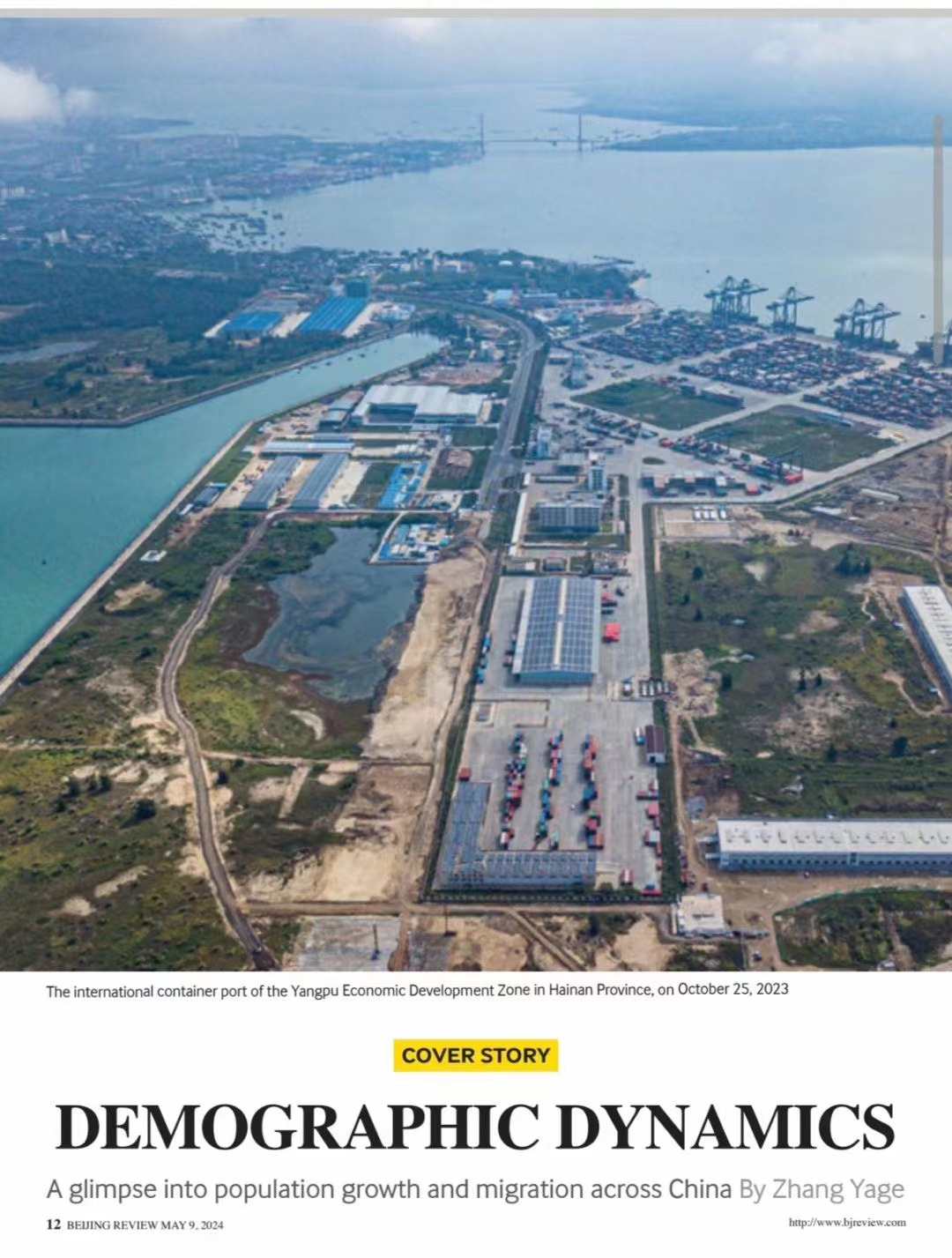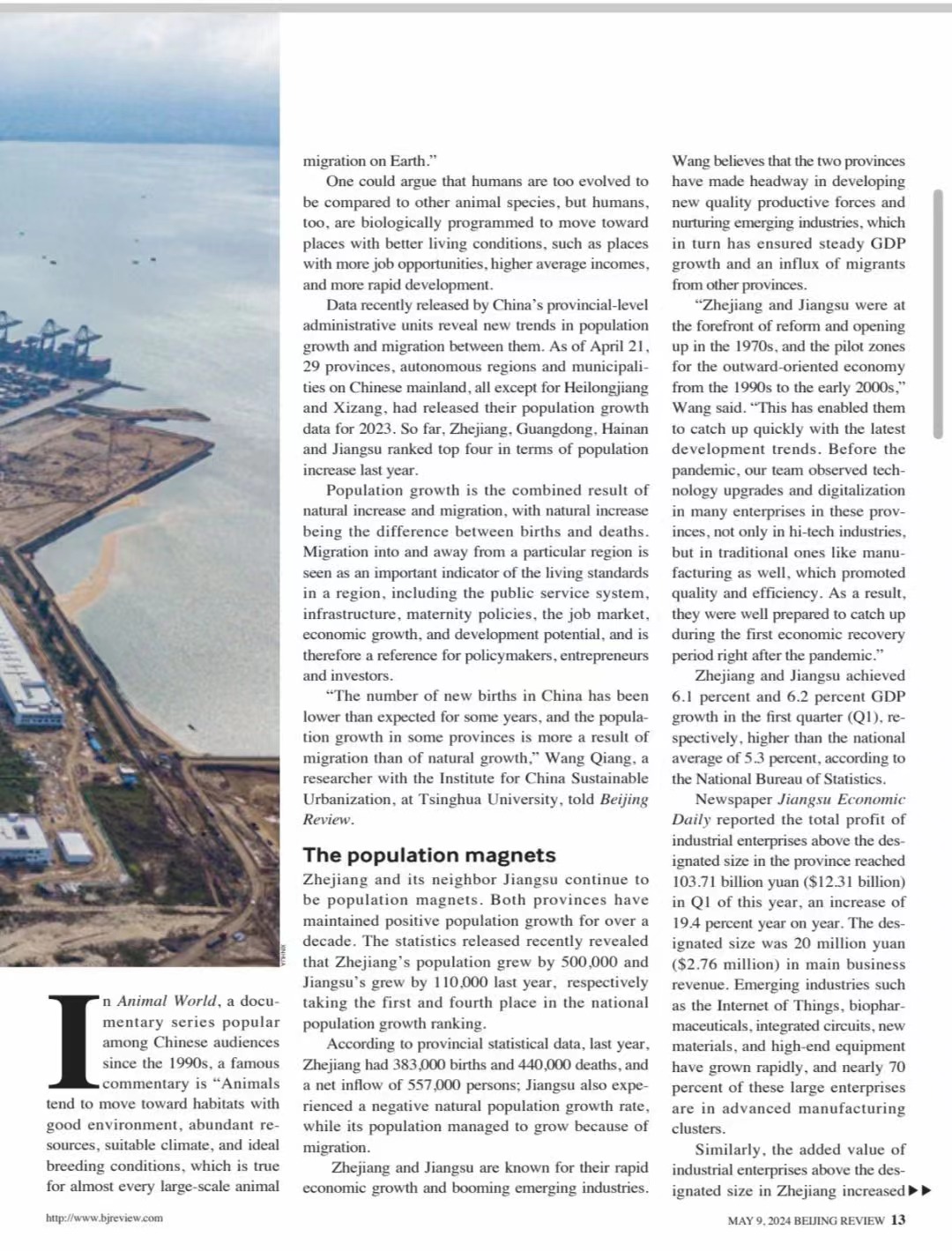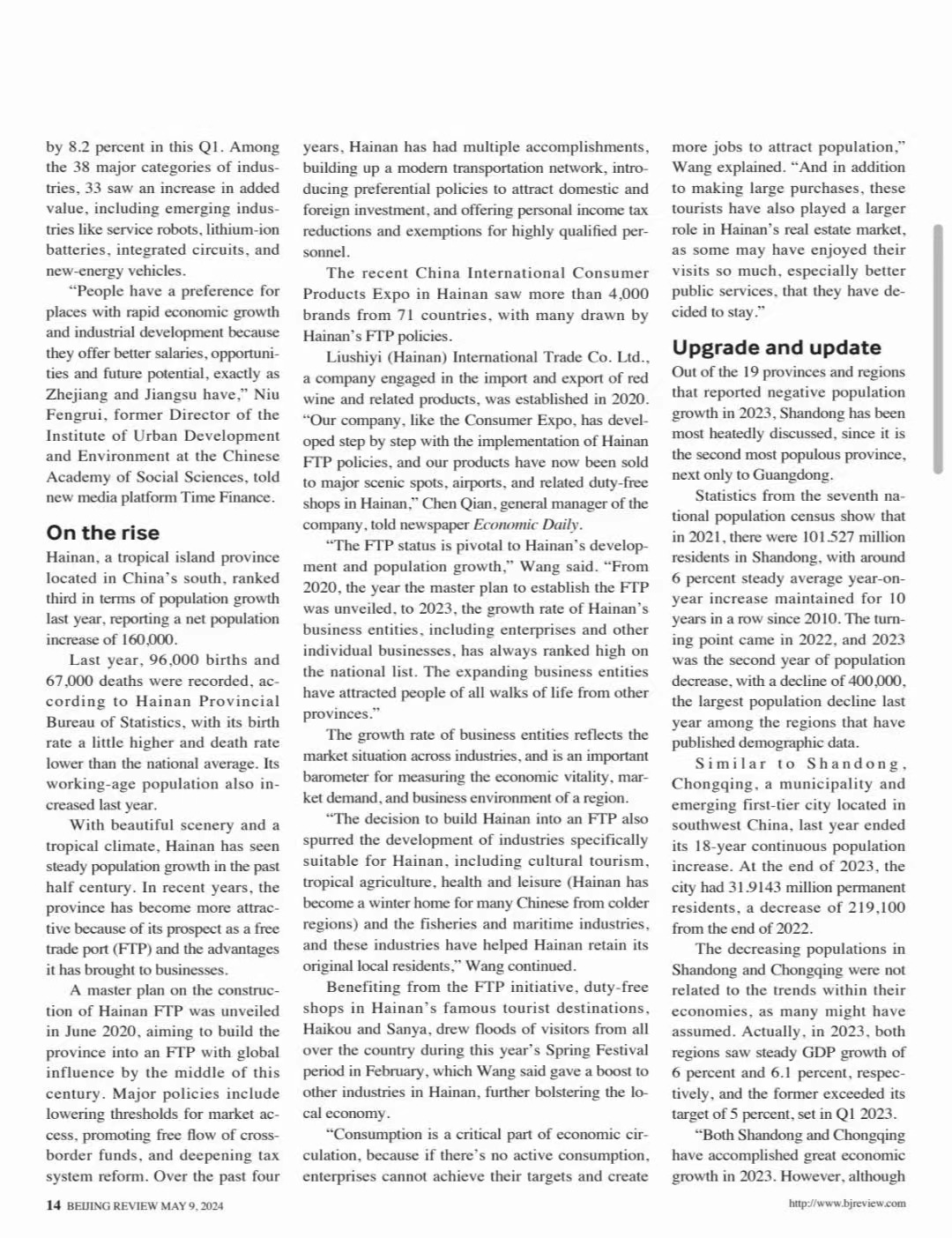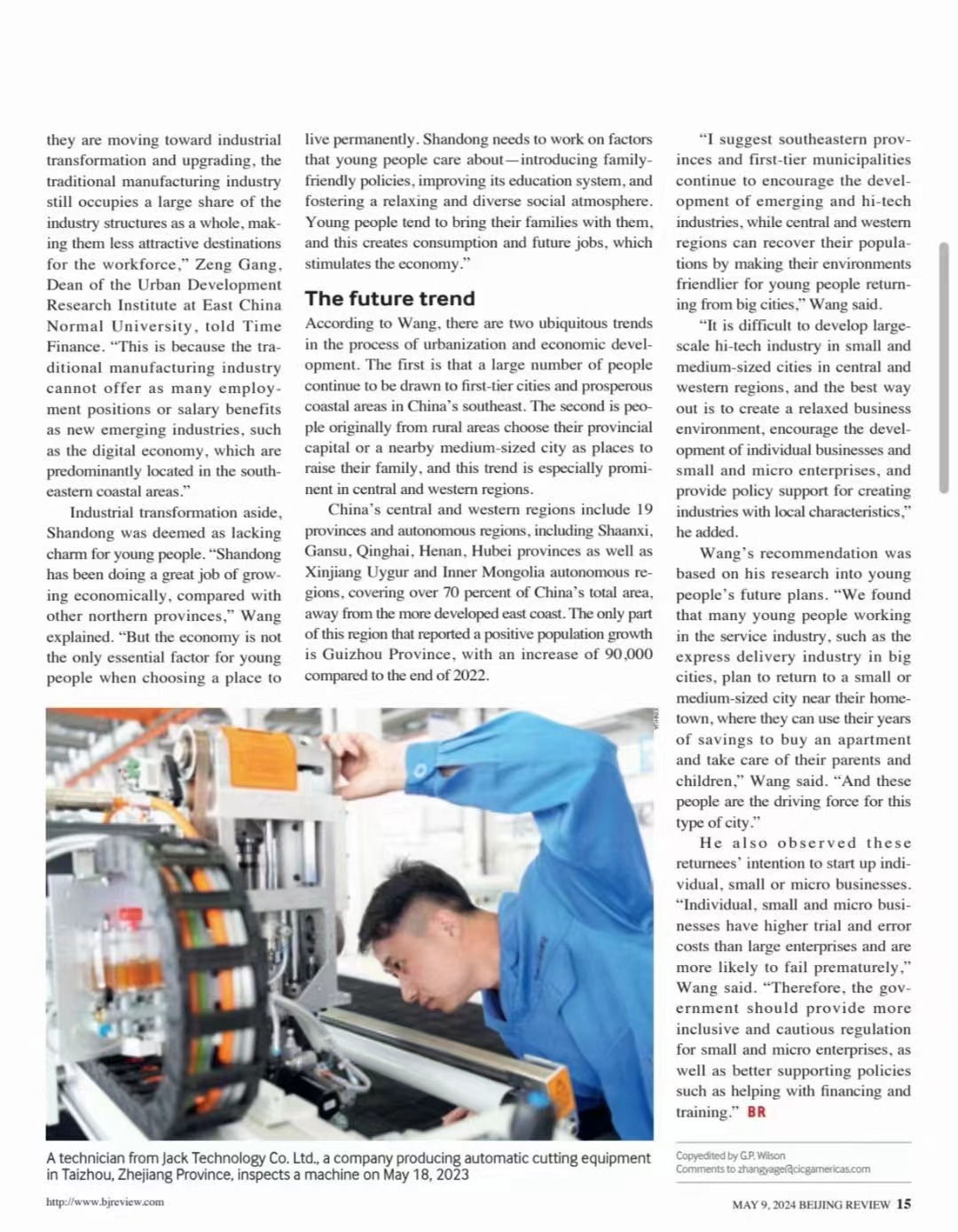截至4月21日,除黑龙江和西藏外,已有29个省、自治区、直辖市陆续公布2023年人口数据。其中,浙江、广东、海南、江苏在人口增长方面排名前四。《北京周报》(BEIJING REVIEW) 对此专访清华大学中国新型城镇化研究院城市群与都市圈研究中心副主任王强。王强表示,我国一些省份的人口增长更多是跨地区人口流动而非自然增长的结果,并对浙江、海南、江苏三地人口正增长及山东人口负增长展开详细分析。王强建议,东南沿海省份和一线城市应继续鼓励新兴产业和前沿科技产业发展,中西部地区可以通过营造良好成长环境,吸引青年人才从大城市返回家乡就业创业,更好兼顾事业发展和照顾老人、培养子女,以此促进人口增长、注入发展活力。
A glimpse into population growth and migration across China
In Animal World, a documentary series popular among Chinese audiences since the 1990s, a famous commentary is "Animals tend to move toward habitats with good environment, abundant resources, suitable climate, and ideal breeding conditions, which is true for almost every large-scale animal migration on Earth."
One could argue that humans are too evolved to be compared to other animal species, but humans, too, are biologically programmed to move toward places with better living conditions, such as places with more job opportunities, higher average incomes, and more rapid development.
Data recently released by China's provincial-level administrative units reveal new trends in population growth and migration between them. As of April 21, 29 provinces, autonomous regions and municipalities on Chinese mainland, all except for Heilongjiang and Xizang, had released their population growth data for 2023. So far, Zhejiang, Guangdong, Hainan and Jiangsu ranked top four in terms of population increase last year.
Population growth is the combined result of natural increase and migration, with natural increase being the difference between births and deaths. Migration into and away from a particular region is seen as an important indicator of the living standards in a region, including the public service system, infrastructure, maternity policies, the job market, economic growth, and development potential, and is therefore a reference for policymakers, entrepreneurs and investors.
"The number of new births in China has been lower than expected for some years, and the population growth in some provinces is more a result of migration than of natural growth," Wang Qiang, a researcher with the Institute for China Sustainable Urbanization, at Tsinghua University, told Beijing Review.
01 The population magnets

A technician from China Jack, a company producing automatic cutting equipment in Taizhou, Zhejiang Province, inspects a machine on May 18, 2023 (XINHUA)
Zhejiang and its neighbor Jiangsu continue to be population magnets. Both provinces have maintained positive population growth for over a decade. The statistics released recently revealed that Zhejiang's population grew by 500,000 and Jiangsu's grew by 110,000 last year, respectively taking the first and fourth place in the national population growth ranking.
According to provincial statistical data, last year, Zhejiang had 383,000 births and 440,000 deaths, and a net inflow of 557,000 persons; Jiangsu also experienced a negative natural population growth rate, while its population managed to grow because of migration.
Zhejiang and Jiangsu are known for their rapid economic growth and booming emerging industries. Wang believes that the two provinces have made headway in developing new quality productive forces and nurturing emerging industries, which in turn has ensured steady GDP growth and an influx of migrants from other provinces.
"Zhejiang and Jiangsu were at the forefront of reform and opening up in the 1970s, and the pilot zones for the outward-oriented economy from the 1990s to the early 2000s," Wang said. "This has enabled them to catch up quickly with the latest development trends. Before the pandemic, our team observed technology upgrades and digitalization in many enterprises in these provinces, not only in hi-tech industries, but in traditional ones like manufacturing as well, which promoted quality and efficiency. As a result, they were well prepared to catch up during the first economic recovery period right after the pandemic."
Zhejiang and Jiangsu achieved 6.1 percent and 6.2 percent GDP growth in the first quarter (Q1), respectively, higher than the national average of 5.3 percent, according to the National Bureau of Statistics.
Newspaper Jiangsu Economic Daily reported the total profit of industrial enterprises above the designated size in the province reached 103.71 billion yuan ($12.31 billion) in Q1 of this year, an increase of 19.4 percent year on year. The designated size was 20 million yuan ($2.76 million) in main business revenue. Emerging industries such as the Internet of Things, biopharmaceuticals, integrated circuits, new materials, and high-end equipment have grown rapidly, and nearly 70 percent of these large enterprises are in advanced manufacturing clusters.
Similarly, the added value of industrial enterprises above the designated size in Zhejiang increased by 8.2 percent in this Q1. Among the 38 major categories of industries, 33 saw an increase in added value, including emerging industries like service robots, lithium-ion batteries, integrated circuits, and new-energy vehicles.
"People have a preference for places with rapid economic growth and industrial development because they offer better salaries, opportunities and future potential, exactly as Zhejiang and Jiangsu have," Niu Fengrui, former Director of the Institute of Urban Development and Environment at the Chinese Academy of Social Sciences, told new media platform Time Finance.
02 On the rise
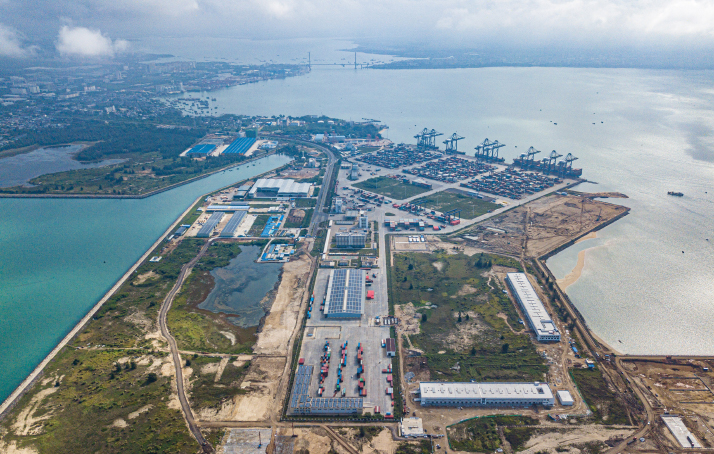
The international container port of the Yangpu Economic Development Zone in Hainan Province, on October 25, 2023 (XINHUA)
Hainan, a tropical island province located in China's south, ranked third in terms of population growth last year, reporting a net population increase of 160,000.
Last year, 96,000 births and 67,000 deaths were recorded, according to Hainan Provincial Bureau of Statistics, with its birth rate a little higher and death rate lower than the national average. Its working-age population also increased last year.
With beautiful scenery and a tropical climate, Hainan has seen steady population growth in the past half century. In recent years, the province has become more attractive because of its prospect as a free trade port (FTP) and the advantages it has brought to businesses.
A master plan on the construction of Hainan FTP was unveiled in June 2020, aiming to build the province into an FTP with global influence by the middle of this century. Major policies include lowering thresholds for market access, promoting free flow of cross-border funds, and deepening tax system reform. Over the past four years, Hainan has had multiple accomplishments, building up a modern transportation network, introducing preferential policies to attract domestic and foreign investment, and offering personal income tax reductions and exemptions for highly qualified personnel.
The recent China International Consumer Products Expo in Hainan saw more than 4,000 brands from 71 countries, with many drawn by Hainan's FTP policies.
Liushiyi (Hainan) International Trade Co. Ltd., a company engaged in the import and export of red wine and related products, was established in 2020. "Our company, like the Consumer Expo, has developed step by step with the implementation of Hainan FTP policies, and our products have now been sold to major scenic spots, airports, and related duty-free shops in Hainan," Chen Qian, general manager of the company, told newspaper Economic Daily.
"The FTP status is pivotal to Hainan's development and population growth," Wang said. "From 2020, the year the master plan to establish the FTP was unveiled, to 2023, the growth rate of Hainan's business entities, including enterprises and other individual businesses, has always ranked high on the national list. The expanding business entities have attracted people of all walks of life from other provinces."
The growth rate of business entities reflects the market situation across industries, and is an important barometer for measuring the economic vitality, market demand, and business environment of a region.
"The decision to build Hainan into an FTP also spurred the development of industries specifically suitable for Hainan, including cultural tourism, tropical agriculture, health and leisure (Hainan has become a winter home for many Chinese from colder regions) and the fisheries and maritime industries, and these industries have helped Hainan retain its original local residents," Wang continued.
Benefiting from the FTP initiative, duty-free shops in Hainan's famous tourist destinations, Haikou and Sanya, drew floods of visitors from all over the country during this year's Spring Festival period in February, which Wang said gave a boost to other industries in Hainan, further bolstering the local economy.
"Consumption is a critical part of economic circulation, because if there's no active consumption, enterprises cannot achieve their targets and create more jobs to attract population," Wang explained. "And in addition to making large purchases, these tourists have also played a larger role in Hainan's real estate market, as some may have enjoyed their visits so much, especially better public services, that they have decided to stay."
03 Upgrade and update
Out of the 19 provinces and regions that reported negative population growth in 2023, Shandong has been most heatedly discussed, since it is the second most populous province, next only to Guangdong.
Statistics from the seventh national population census show that in 2021, there were 101.527 million residents in Shandong, with around 6 percent steady average year-on-year increase maintained for 10 years in a row since 2010. The turning point came in 2022, and 2023 was the second year of population decrease, with a decline of 400,000, the largest population decline last year among the regions that have published demographic data.
Similar to Shandong, Chongqing, a municipality and emerging first-tier city located in southwest China, last year ended its 18-year continuous population increase. At the end of 2023, the city had 31.9143 million permanent residents, a decrease of 219,100 from the end of 2022.
The decreasing populations in Shandong and Chongqing were not related to the trends within their economies, as many might have assumed. Actually, in 2023, both regions saw steady GDP growth of 6 percent and 6.1 percent, respectively, and the former exceeded its target of 5 percent, set in Q1 2023.
"Both Shandong and Chongqing have accomplished great economic growth in 2023. However, although they are moving toward industrial transformation and upgrading, the traditional manufacturing industry still occupies a large share of the industry structures as a whole, making them less attractive destinations for the workforce," Zeng Gang, Dean of the Urban Development Research Institute at East China Normal University, told Time Finance. "This is because the traditional manufacturing industry cannot offer as many employment positions or salary benefits as new emerging industries, such as the digital economy, which are predominantly located in the southeastern coastal areas."
Industrial transformation aside, Shandong was deemed as lacking charm for young people. "Shandong has been doing a great job of growing economically, compared with other northern provinces," Wang explained. "But the economy is not the only essential factor for young people when choosing a place to live permanently. Shandong needs to work on factors that young people care about—introducing family-friendly policies, improving its education system, and fostering a relaxing and diverse social atmosphere. Young people tend to bring their families with them, and this creates consumption and future jobs, which stimulates the economy."
04 The future trend
According to Wang, there are two ubiquitous trends in the process of urbanization and economic development. The first is that a large number of people continue to be drawn to first-tier cities and prosperous coastal areas in China's southeast. The second is people originally from rural areas choose their provincial capital or a nearby medium-sized city as places to raise their family, and this trend is especially prominent in central and western regions.
China's central and western regions include 19 provinces and autonomous regions, including Shaanxi, Gansu, Qinghai, Henan, Hubei provinces as well as Xinjiang Uygur and Inner Mongolia autonomous regions, covering over 70 percent of China's total area, away from the more developed east coast. The only part of this region that reported a positive population growth is Guizhou Province, with an increase of 90,000 compared to the end of 2022.
"I suggest southeastern provinces and first-tier municipalities continue to encourage the development of emerging and hi-tech industries, while central and western regions can recover their populations by making their environments friendlier for young people returning from big cities," Wang said.
"It is difficult to develop large-scale hi-tech industry in small and medium-sized cities in central and western regions, and the best way out is to create a relaxed business environment, encourage the development of individual businesses and small and micro enterprises, and provide policy support for creating industries with local characteristics," he added.
Wang's recommendation was based on his research into young people's future plans. "We found that many young people working in the service industry, such as the express delivery industry in big cities, plan to return to a small or medium-sized city near their hometown, where they can use their years of savings to buy an apartment and take care of their parents and children," Wang said. "And these people are the driving force for this type of city."
He also observed these returnees' intention to start up individual, small or micro businesses. "Individual, small and micro businesses have higher trial and error costs than large enterprises and are more likely to fail prematurely," Wang said. "Therefore, the government should provide more inclusive and cautious regulation for small and micro enterprises, as well as better supporting policies such as helping with financing and training."
来源:《北京周报》(BEIJING REVIEW) 2024年5月6日第19期
作者:北京周报记者 张雅格
Print Edition: Demographic Dynamics
